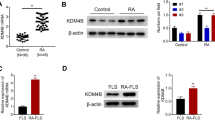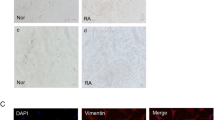Abstract
Rheumatoid arthritis (RA) is a chronic inflammatory disease with persistent inflammation and progressive joint damage. However, the underlying pathological mechanisms of RA are still unclear. Fibroblast‑like synoviocytes (FLSs) play an important role in the pathogenesis of RA by the regulation of proliferation and apoptosis, and the release of multiple pro-inflammatory factors. The lipid mediator sphingosine-1-phosphate receptor 4 (S1PR4) is one of the sphingolipid sphingosine-1-phosphate (S1P) receptors, which affects the function of immune cells. However, the role of S1PR4 in the activation of FLSs and the development of RA is unknown. In this study, we found that the expression of S1PR4 was significantly increased in RA-FLSs. The silence of S1PR4 decreases the proliferation, migration, proinflammation, and promotes the apoptosis of RA-FLSs, accompanied with repressing interleukin-17 (IL-17)/signal transducer and activator of transcription 3 (STAT3) signal pathway. However, the regulatory effects of S1PR4 silencing on RA-FLSs were partly abolished by additional recombinant human (rh) IL-17A treatment. Therefore, our study demonstrated that S1PR4 silencing might inhibit proliferation, migration, proinflammation, and promote apoptosis of RA-FLSs partly by repressing IL-17, which suggests that inhibitors for S1PR4 might be a potentially promising strategy for the treatment of RA.





Similar content being viewed by others
Data Availability
The datasets used and/or analyzed during the current study are available from the corresponding author on reasonable request.
References
Zhou, D.J., et al. 2020. Driving ability and safety in rheumatoid arthritis: A systematic review. Arthritis Care Res (Hoboken). https://doi.org/10.1002/acr.24137.
Zhao, S.S., H. Lyu, D.H. Solomon, and K. Yoshida. 2020. Improving rheumatoid arthritis comparative effectiveness research through causal inference principles: Systematic review using a target trial emulation framework. Annals of the Rheumatic Diseases 79: 883–890. https://doi.org/10.1136/annrheumdis-2020-217200.
Zafari, P., et al. 2020. Asymmetric and symmetric dimethylarginine concentration as an indicator of cardiovascular diseases in rheumatoid arthritis patients: A systematic review and meta-analysis of case-control studies. Clinical Rheumatology 39: 127–134. https://doi.org/10.1007/s10067-019-04713-z.
Wang, Z., Bao, H.W. and Y.A., Ji. 2020. systematic review and meta-analysis of rituximab combined with methotrexate versus methotrexate alone in the treatment of rheumatoid arthritis. Medicine (Baltimore) 99: e19193.https://doi.org/10.1097/MD.0000000000019193.
Zhang, L., P. Cai, and W. Zhu. 2020. Depression has an impact on disease activity and health-related quality of life in rheumatoid arthritis: A systematic review and meta-analysis. International Journal of Rheumatic Diseases 23: 285–293. https://doi.org/10.1111/1756-185X.13774.
Wang, H., X., Li, and G. Gong. 2020. Cardiovascular outcomes in patients with co-existing coronary artery disease and rheumatoid arthritis: A systematic review and meta-analysis. Medicine (Baltimore) 99: e19658. https://doi.org/10.1097/MD.0000000000019658.
Vasconcelos, L.B., M.T. Silva, and T.F. Galvao. 2020. Reduction of biologics in rheumatoid arthritis: A systematic review and meta-analysis. Rheumatology International. https://doi.org/10.1007/s00296-020-04651-z.
Silvagni, E., et al. 2020. One year in review 2020: Novelties in the treatment of rheumatoid arthritis. Clinical and Experimental Rheumatology 38: 181–194.
Dietze, A., B. Engesaeter, and K. Berg. 2005. Transgene delivery and gelonin cytotoxicity enhanced by photochemical internalization in fibroblast-like synoviocytes (FLS) from rheumatoid arthritis patients. Photochemical & Photobiological Sciences 4: 341–347. https://doi.org/10.1039/b416521g.
Kraan, M.C., et al. 2004. T cells, fibroblast-like synoviocytes, and granzyme B+ cytotoxic cells are associated with joint damage in patients with recent onset rheumatoid arthritis. Annals of the Rheumatic Diseases 63: 483–488. https://doi.org/10.1136/ard.2003.009225.
Zhai, K.F., et al. 2017. Protective effects of paeonol on inflammatory response in IL-1beta-induced human fibroblast-like synoviocytes and rheumatoid arthritis progression via modulating NF-kappaB pathway. Inflammopharmacology. https://doi.org/10.1007/s10787-017-0385-5.
Zhu, L., and L. Zhu. 2017. Sophocarpine suppress inflammatory response in human fibroblast-like synoviocytes and in mice with collagen-induced arthritis. European Cytokine Network 28: 120–126. https://doi.org/10.1684/ecn.2017.0400.
Agonia, I., et al. 2020. IL-17, IL-21 and IL-22 polymorphisms in rheumatoid arthritis: A systematic review and meta-analysis. Cytokine 125: 154813. https://doi.org/10.1016/j.cyto.2019.154813.
Yang, P., et al. 2019. Th17 cell pathogenicity and plasticity in rheumatoid arthritis. Journal of Leukocyte Biology 106: 1233–1240. https://doi.org/10.1002/JLB.4RU0619-197R.
Mohammadi, F.S., et al. 2019. Are genetic variations in IL-21-IL-23R-IL-17A cytokine axis involved in a pathogenic pathway of rheumatoid arthritis? Bayesian hierarchical meta-analysis. Journal Cell Physiology 234: 17159–17171. https://doi.org/10.1002/jcp.28495.
Taams, L.S. 2020. Interleukin-17 in rheumatoid arthritis: trials and tribulations. The Journal of Experimental Medicine 217. https://doi.org/10.1084/jem.20192048.
van Hamburg, J.P., and S.W. Tas. 2018. Molecular mechanisms underpinning T helper 17 cell heterogeneity and functions in rheumatoid arthritis. Journal of Autoimmunity 87: 69–81. https://doi.org/10.1016/j.jaut.2017.12.006.
Agarwal, S., R. Misra, and A. Aggarwal. 2010. Induction of metalloproteinases expression by TLR ligands in human fibroblast like synoviocytes from juvenile idiopathic arthritis patients. Indian Journal of Medical Research 131: 771–779.
Samarpita, S., R. Ganesan, and M. Rasool. 2020. Cyanidin prevents the hyperproliferative potential of fibroblast-like synoviocytes and disease progression via targeting IL-17A cytokine signalling in rheumatoid arthritis. Toxicology and Applied Pharmacology 391: 114917. https://doi.org/10.1016/j.taap.2020.114917.
Chen, S., et al. 2020. Interleukin 17A and IL-17F expression and functional responses in rheumatoid arthritis and peripheral spondyloarthritis. Journal of Rheumatology 47: 1606–1613. https://doi.org/10.3899/jrheum.190571.
Lee, S.Y., et al. 2014. Interleukin-17 increases the expression of Toll-like receptor 3 via the STAT3 pathway in rheumatoid arthritis fibroblast-like synoviocytes. Immunology 141: 353–361. https://doi.org/10.1111/imm.12196.
Lao, M., et al. 2016. Protein Inhibitor of activated STAT3 regulates migration, invasion, and activation of fibroblast-like synoviocytes in rheumatoid arthritis. The Journal of Immunology 196: 596–606. https://doi.org/10.4049/jimmunol.1403254.
Olesch, C., C. Ringel, B. Brune, and A. Weigert. 2017. Beyond immune cell migration: The emerging role of the sphingosine-1-phosphate receptor S1PR4 as a modulator of innate immune cell activation. Mediators of Inflammation 2017: 6059203. https://doi.org/10.1155/2017/6059203.
Xiong, Y., et al. 2019. CD4 T cell sphingosine 1-phosphate receptor (S1PR)1 and S1PR4 and endothelial S1PR2 regulate afferent lymphatic migration. Science Immunology 4. https://doi.org/10.1126/sciimmunol.aav1263.
Schuster, C., et al. 2020. S1PR4-dependent CCL2 production promotes macrophage recruitment in a murine psoriasis model. European Journal of Immunology 50: 839–845. https://doi.org/10.1002/eji.201948349.
Olesch, C., et al. 2020. S1PR4 ablation reduces tumor growth and improves chemotherapy via CD8+ T cell expansion. The Journal of Clinical Investigation. https://doi.org/10.1172/JCI136928.
Burg, N., J.E. Salmon, and T. Hla. 2022. Sphingosine 1-phosphate receptor-targeted therapeutics in rheumatic diseases. Nature Reviews Rheumatology 18: 335–351. https://doi.org/10.1038/s41584-022-00784-6.
Wang, M., et al. 2021. Inhibition of sphingosine 1-phosphate (S1P) receptor 1/2/3 ameliorates biological dysfunction in rheumatoid arthritis fibroblast-like synoviocyte MH7A cells through Galphai/Galphas rebalancing. Clinical and Experimental Pharmacology and Physiology 48: 1080–1089. https://doi.org/10.1111/1440-1681.13460.
Kalden, J.R., and H. Schulze-Koops. 2017. Immunogenicity and loss of response to TNF inhibitors: Implications for rheumatoid arthritis treatment. Nature Reviews Rheumatology 13: 707–718. https://doi.org/10.1038/nrrheum.2017.187.
Bonelli, M., et al. 2019. IRF1 is critical for the TNF-driven interferon response in rheumatoid fibroblast-like synoviocytes: JAKinibs suppress the interferon response in RA-FLSs. Experimental & Molecular Medicine 51: 75. https://doi.org/10.1038/s12276-019-0267-6.
Sun, M., et al. 2020. Sphingosine kinase 1/sphingosine 1-phosphate/sphingosine 1-phosphate receptor 1 pathway: A novel target of geniposide to inhibit angiogenesis. Life Sciences 256: 117988. https://doi.org/10.1016/j.lfs.2020.117988.
Inoue, T., et al. 2019. Upregulation of sphingosine-1-phosphate receptor 3 on fibroblast-like synoviocytes is associated with the development of collagen-induced arthritis via increased interleukin-6 production. PLoS ONE 14: e0218090. https://doi.org/10.1371/journal.pone.0218090.
Perez-Jeldres, T., M. Alvarez-Lobos, and J. Rivera-Nieves. 2021. Targeting sphingosine-1-phosphate signaling in immune-mediated diseases: Beyond multiple sclerosis. Drugs 81: 985–1002. https://doi.org/10.1007/s40265-021-01528-8.
Bigaud, M., et al. 2016. Pathophysiological consequences of a break in S1P1-dependent homeostasis of vascular permeability revealed by S1P1 competitive antagonism. PLoS ONE 11: e0168252. https://doi.org/10.1371/journal.pone.0168252.
Lee, C.F., et al. 2019. Activation of sphingosine kinase by lipopolysaccharide promotes prostate cancer cell invasion and metastasis via SphK1/S1PR4/matriptase. Oncogene 38: 5580–5598. https://doi.org/10.1038/s41388-019-0833-3.
Hong, C.H., et al. 2022. Sphingosine 1-phosphate receptor 4 promotes nonalcoholic steatohepatitis by activating NLRP3 inflammasome. Cellular and Molecular Gastroenterology and Hepatology 13: 925–947. https://doi.org/10.1016/j.jcmgh.2021.12.002.
Dillmann, C., J. Mora, C. Olesch, B. Brune, and A. Weigert. 2015. S1PR4 is required for plasmacytoid dendritic cell differentiation. Biological Chemistry 396: 775–782. https://doi.org/10.1515/hsz-2014-0271.
Suh, J.H., et al. 2018. Sphingosine-1-phosphate signaling and metabolism gene signature in pediatric inflammatory bowel disease: A matched-case control pilot study. Inflammatory Bowel Diseases 24: 1321–1334. https://doi.org/10.1093/ibd/izy007.
Zhang, J., et al. 2019. Profibrotic effect of IL-17A and elevated IL-17RA in idiopathic pulmonary fibrosis and rheumatoid arthritis-associated lung disease support a direct role for IL-17A/IL-17RA in human fibrotic interstitial lung disease. American Journal of Physiology. Lung Cellular and Molecular Physiology 316: L487–L497. https://doi.org/10.1152/ajplung.00301.2018.
Lee, S.Y., et al. 2013. IL-17-mediated Bcl-2 expression regulates survival of fibroblast-like synoviocytes in rheumatoid arthritis through STAT3 activation. Arthritis Research & Therapy 15: R31. https://doi.org/10.1186/ar4179.
Chang, L., X. Feng, and W. Gao. 2019. Proliferation of rheumatoid arthritis fibroblast-like synoviocytes is enhanced by IL-17-mediated autophagy through STAT3 activation. Connective Tissue Research 60: 358–366. https://doi.org/10.1080/03008207.2018.1552266.
Author information
Authors and Affiliations
Contributions
ZS designed the study. PZ and QZ conducted the experiments, collected and analyzed the data. PZ wrote the manuscript. ZS revised the manuscript. All authors reviewed the manuscript.
Corresponding author
Ethics declarations
Conflict of Interests
The authors declare no competing interests.
Additional information
Publisher's Note
Springer Nature remains neutral with regard to jurisdictional claims in published maps and institutional affiliations.
Rights and permissions
Springer Nature or its licensor holds exclusive rights to this article under a publishing agreement with the author(s) or other rightsholder(s); author self-archiving of the accepted manuscript version of this article is solely governed by the terms of such publishing agreement and applicable law.
About this article
Cite this article
Zhang, P., Zhang, Q. & Shao, Z. Silence of S1PR4 Represses the Activation of Fibroblast-like Synoviocytes by Regulating IL-17/STAT3 Signaling Pathway. Inflammation 46, 234–243 (2023). https://doi.org/10.1007/s10753-022-01728-8
Received:
Revised:
Accepted:
Published:
Issue Date:
DOI: https://doi.org/10.1007/s10753-022-01728-8




